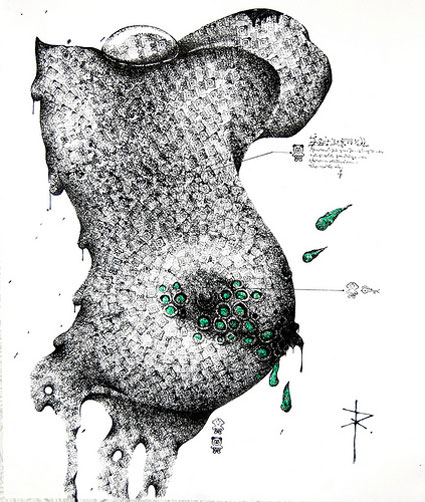Rebeca Olguin
Little Cosmogony of Fantasy
Populated by contorted chimeras, the images of Rebeca Olguín, much like the bestiaries of the Middle Ages, ask those who seek to penetrate their meaning to see them as signs rather than symbols. For if the symbol, in its very materiality, relates directly to that which it symbolizes, the sign, meanwhile, is always a sign of something else. It is clear in her series of “Artifacts” that Rebeca Olguín is not asking us to simply see the objects of her fantasies, but rather she invites us to ponder their origins and, most certainly, the basis of their metamorphoses.
Little Cosmogony of Fantasy
“It is illness that was the ultimate basis of the creative impulse; in creating I could heal, in creating I found health.” Heinrich Heine
Whether in her drawing entitled Desiregn, or another, more enigmatic piece, Interface Gadgets, one thing seems fairly certain: Rebeca Olguín has created forms of uncertain, or even floating, identity. Endlessly oscillating between two states—sometimes male, sometimes female—these naïve artifacts of compulsion are first and foremost instantiations of a primordial, “phallic” form; in other words, a form representing desire as it seeks to reclaim the lost object—the object of love. That is why the value of each of these creatures lies in their representation of the transitory and fragile state of their being, a state whose lack of identity is matched only by the power of the desire that pushes it to transform.
To this first formal aspect we must add another. Much like ancient philosophers believed the cosmos were nothing more than a deployment, in the form of four elements (water, air, earth, and fire), of a breath (pneuma) or an impersonal energy, the polymorphism of these works is based, too, on the juxtaposition of four figures whose simplicity contrasts with the forms they give rise to—as if the most enigmatic fantasies of our adult lives were nothing but a series of variations around a small number of the most primitive forms, that take root in the heart of archetypes that populate our unconscious.
That is why, perhaps, Rebeca Olguín chose to describe these figures using a language that doesn’t communicate any information to their viewers. Comparable, in this regard, to the structure of a symptom whose role is to attract attention rather than communicate a precise knowledge, these notations play the role of decoy in the overall economy of these drawings. Since it is not a language—it only seems to be—these references function as traps: they attract the attention of anyone who tries to better understand the message, while the viewer then plunges, in the next moment, into the most total wonderment.

Faithful to the teachings of Freud, these works allow us to see—and understand—that our fantasies are nothing but the superposition of more primitive images whose provenance and meaning cannot be assigned from the outside. Rephrased as questions, this is what the silence of these works asks us: which side of the phallus does your desire lean, the side of the man or the woman? Above all: what are the archetypes from which unfold your fantasies?
Frédéric-Charles Baitinger
Rebeca Olguin
www.rebecaolguin.comGalerie Numu Arts collective
Liminal Bodies
du 23 Juillet 2010 au 5 Août 2011
75 Stewart Ave, Brooklyn, NY, 11237
www.numuartscollective.org
